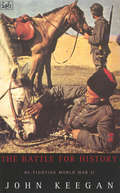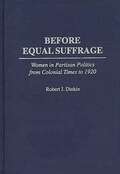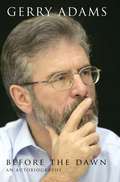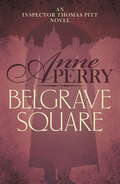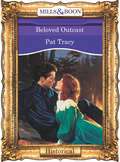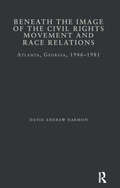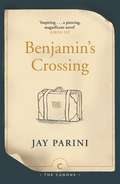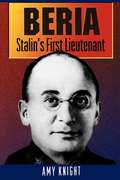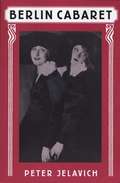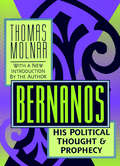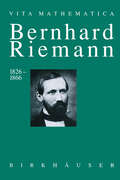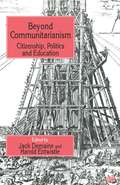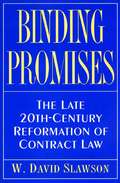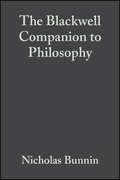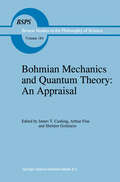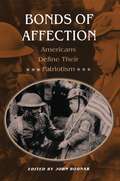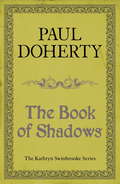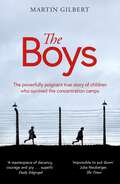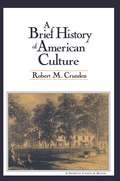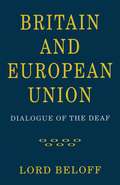- Table View
- List View
The Battle For History: Refighting World War Two (The\barbara Frum Lecture Ser.)
by John KeeganAlthough 50 years have passed since the end of World War II, there has as yet been no definitive history of that conflict. Existing histories have raised as many questions as they answer: Did Roosevelt have foreknowledge of the attack on Pearl Harbour? Could the Allies have invaded France before 1944? Might bombing the Auschwitz railway have impeded the course of the Holocaust? John Keegan here assesses the literature that has emerged from World War II - and the controversies it has generated - in a book that combines stunning erudition with crisp prose and highly personal discernment.
Before Equal Suffrage: Women in Partisan Politics from Colonial Times to 1920 (Contributions in Women's Studies)
by Robert J. DinkinDispelling the myth that women became involved in partisan politics only after they obtained the vote, this study uses contemporary newspaper sources to show that women were active in the party struggle long before 1920. Although their role was initially limited to attending rallies and hosting picnics, they gradually began to use their pens and voices to support party tickets. By the late 19th century, women spoke at party functions and organized all-female groups to help canvass neighborhoods and get out the vote. In the early suffrage states of the West, they voted in increasing numbers and even held a few offices.Women were particularly active, this book shows, in the minor reformist parties—Populist, Prohibitionist, Socialist, and Progressive—but eventually came to play a role in the major parties as well. Prominent suffrage leaders, such as Elizabeth Cady Stanton and Susan B. Anthony, entered the partisan arena in order to promote their cause. By the time the suffrage amendment was ratified, women were deeply involved in the mainstream political process.
Before the Dawn: An Autobiography
by Gerry AdamsThe controversial autobiography of the man at the heart of Irish Republican politics. Sinn Fein leader Gerry Adams offers his own unique, intimate account of the early years of his career, from his childhood in working-class Belfast to the more turbulent years of social activism that followed. An engaging and revealing self-portrait. Born in West Belfast in 1948 into a family with close ties to both the trade union and republican movements, his childhood, despite its material poverty, he has described in glowing and humorous terms. For many years his voice was banned from radio and television by both the British and Irish governments, while commentators and politicians condemned him and all he stood for. But through those years Brandon published a succession of books which made an important contribution to an understanding of the true circumstances of life and politics in the north of Ireland. In his autobiography, Before the Dawn, Gerry Adams brings a unique perspective to the years of conflict, insurrection and bitter struggle which ensued when peaceful political agitation was met with hysterical reaction and the sectarian tinderbox of Britain's last colony erupted. From the pogroms of 1969 to the hunger strikes of 1981, from the streets of West Belfast to the cages of Long Kesh, his powerful memoir is essential reading for anyone wishing to understand modern Ireland.
Belgrave Square: A gripping mystery of blackmail and murder on the streets of Victorian London (Thomas Pitt Mystery #12)
by Anne PerryWill the hidden layers of conspiracy triumph before Pitt can solve the case? A grisly murder of a moneylender draws Inspector Pitt once more into a world of power and greed in Anne Perry's Belgrave Square. Perfect for fans of C. J. Samson and Sherlock Holmes. '[Anne] Perry's characters are vivid and well-drawn... If you want to be privy to the romance, politics, and scandal of Victorian London, this descriptive, leisurely paced mystery may well be your cup of Earl Grey tea' - Houston Chronicle The murder in Clerkenwell of an obscure moneylender named William Weems brings discreet rejoicing among those whose meagre earnings he so mercilessly devoured. Yet when Inspector Thomas Pitt finds a list including some of London's most distinguished gentlemen in Weems' office, he begins to realize this was no common usurer but a vicious blackmailer. Charlotte Pitt has connections to this distinguished London society, and, at glittering balls and over gossipy tea tables, she begins to perceive a world of passion, power, and greed that the police are seldom permitted to see... What readers are saying about Belgrave Square: 'Brilliant set of books. Will carry on reading them as fast as Anne Perry writes them, they are simply the best''I love all Anne Perry books, this was no exception, [was] sorry when I got to the end''Five stars'
Beloved Outcast (Mills And Boon Vintage 90s Modern Ser.)
by Pat TracyThe Wagons Went West - Without Her, but nothing could stop Victoria Amory from pursuing her "great adventure." Not even a reprobate like Logan Youngblood, whose lazy-lidded gaze and lopsided grin dared her to do things that should have made her blush - but didn't!
Beneath the Image of the Civil Rights Movement and Race Relations: Atlanta, GA 1946-1981 (Studies in African American History and Culture)
by David A. HarmonThis study is the story of the local Civil Rights Movement and race relations in Atlanta, Georgia from 1946 to 1981. Most examinations of the Civil Rights Movement have been written from a national perspective. These studies have presented local African American protest movements as part of a national campaign for civil rights that lasted approximately from 1955, the Montgomery Bus Boycott, to 1968, the assassination of Dr. Martin Luther King, Jr. In this context, demonstrations in Montgomery, Greensboro, Albany, Birmingham, Selma, and Memphis have been viewed as prototypical African American protest, movements and milestones in this national campaign for civil rights. First published in 1996. Routledge is an imprint of Taylor & Francis, an informa company.
Beneath the Image of the Civil Rights Movement and Race Relations: Atlanta, GA 1946-1981 (Studies in African American History and Culture)
by David A. HarmonThis study is the story of the local Civil Rights Movement and race relations in Atlanta, Georgia from 1946 to 1981. Most examinations of the Civil Rights Movement have been written from a national perspective. These studies have presented local African American protest movements as part of a national campaign for civil rights that lasted approximately from 1955, the Montgomery Bus Boycott, to 1968, the assassination of Dr. Martin Luther King, Jr. In this context, demonstrations in Montgomery, Greensboro, Albany, Birmingham, Selma, and Memphis have been viewed as prototypical African American protest, movements and milestones in this national campaign for civil rights. First published in 1996. Routledge is an imprint of Taylor & Francis, an informa company.
Benjamin's Crossing (Canons)
by Jay PariniThere is no such thing as history, you see. It's a dream, perhaps even a dream of a dream . . . Walter Benjamin is dead. One of the most radiant minds of the twentieth century has been snatched away by death in a small town on the border between Spain and France. His thousand-page manuscript, carried the length of France during his flight from the Nazis, has vanished with him, never to be recovered. Jay Parini's extraordinary work traces Benjamin's steps back through time, from the salons of Berlin to the winding roads of Catalonia. A tale of escape and pursuit, Benjamin's Crossing dramatises one of the most moving peripheral episodes of the Holocaust; and above all, it is a love story.
Beria: Stalin's First Lieutenant (PDF)
by Amy KnightThis is the first comprehensive biography of Lavrentii Beria, Stalin's notorious police chief and for many years his most powerful lieutenant. Beria has long symbolized all the evils of Stalinism, haunting the public imagination both in the West and in the former Soviet Union. Yet because his political opponents expunged his name from public memory after his dramatic arrest and execution in 1953, little has been previously published about his long and tumultuous career.
Berlin Cabaret (Studies in Cultural History)
by Peter JelavichStep into Ernst Wolzogen's Motley Theater, Max Reinhardt's Sound and Smoke, Rudolf Nelson's Chat noir, and Friedrich Hollaender's Tingel-Tangel. Enjoy Claire Waldoff's rendering of a lower-class Berliner, Kurt Tucholsky's satirical songs, and Walter Mehring's Dadaist experiments, as Peter Jelavich spotlights Berlin's cabarets from the day the curtain first went up, in 1901, until the Nazi regime brought it down. Fads and fashions, sexual mores and political ideologies--all were subject to satire and parody on the cabaret stage. This book follows the changing treatment of these themes, and the fate of cabaret itself, through the most turbulent decades of modern German history: the prosperous and optimistic Imperial age, the unstable yet culturally inventive Weimar era, and the repressive years of National Socialism. By situating cabaret within Berlin's rich landscape of popular culture and distinguishing it from vaudeville and variety theaters, spectacular revues, prurient "nude dancing," and Communist agitprop, Jelavich revises the prevailing image of this form of entertainment. Neither highly politicized, like postwar German Kabarett, nor sleazy in the way that some American and European films suggest, Berlin cabaret occupied a middle ground that let it cast an ironic eye on the goings-on of Berliners and other Germans. However, it was just this satirical attitude toward serious themes, such as politics and racism, that blinded cabaret to the strength of the radical right-wing forces that ultimately destroyed it. Jelavich concludes with the Berlin cabaret artists' final performances--as prisoners in the concentration camps at Westerbork and Theresienstadt. This book gives us a sense of what the world looked like within the cabarets of Berlin and at the same time lets us see, from a historical distance, these lost performers enacting the political, sexual, and artistic issues that made their city one of the most dynamic in Europe.
Bernanos: His Political Thought and Prophecy
by Thomas MolnarThomas Molnar's Bernanos is an illuminating study of the personal evolution of the French Catholic novelist Georges Bernanos from a reactionary royalist to a religiously principled anti-fascist. It also provides a detailed account of the intellectual divisions within the French Catholic Right and suggests a number of parallels with intellectual and literary figures on the secular and religious left including Zola, Peguy, and Simone Weil. But, as Molnar points out, the significance of Bernanos is not exhausted by his writings. Bernanos the man is as deserving of attention as is Bernanos the novelist, essayist, and social critic.Molnar shows Bernanos against the troubled political-religious background of modern France: the Dreyfus case, the disillusionment following World War I, the Franco regime, Vichy, and the beginnings of the cold war. Whatever touched France touched Bernanos, and he flung himself into each crisis, not armed with a political system nor an academically sanctioned philosophy, but with a peasant's respect for what is and a Christian's sense of what might be. The portrait that Molnar draws is that of a passionately concerned Christian who knows that truth is hard to come by, but who is ready to follow it wherever it leads, regardless of the consequences.A crucial theme covered by Molnar is Bernanos' long and conflicted relations with Charles Maurras and the Action Francaise. He makes clear the extent to which Bernanos' fervent Catholicism set him apart from Maurras whose positivistic inspiration and passion for order helped lay the groundwork for the political collapse that led to the Vichy regime. Thomas Molnar's book is a fascinating account of Georges Bernanos' stature as both a political thinker and an important novelist. Bernanos will be enjoyed by historians, political scientists, philosophers, theologians, and scholars of literature.
Bernanos: His Political Thought and Prophecy
by Thomas MolnarThomas Molnar's Bernanos is an illuminating study of the personal evolution of the French Catholic novelist Georges Bernanos from a reactionary royalist to a religiously principled anti-fascist. It also provides a detailed account of the intellectual divisions within the French Catholic Right and suggests a number of parallels with intellectual and literary figures on the secular and religious left including Zola, Peguy, and Simone Weil. But, as Molnar points out, the significance of Bernanos is not exhausted by his writings. Bernanos the man is as deserving of attention as is Bernanos the novelist, essayist, and social critic.Molnar shows Bernanos against the troubled political-religious background of modern France: the Dreyfus case, the disillusionment following World War I, the Franco regime, Vichy, and the beginnings of the cold war. Whatever touched France touched Bernanos, and he flung himself into each crisis, not armed with a political system nor an academically sanctioned philosophy, but with a peasant's respect for what is and a Christian's sense of what might be. The portrait that Molnar draws is that of a passionately concerned Christian who knows that truth is hard to come by, but who is ready to follow it wherever it leads, regardless of the consequences.A crucial theme covered by Molnar is Bernanos' long and conflicted relations with Charles Maurras and the Action Francaise. He makes clear the extent to which Bernanos' fervent Catholicism set him apart from Maurras whose positivistic inspiration and passion for order helped lay the groundwork for the political collapse that led to the Vichy regime. Thomas Molnar's book is a fascinating account of Georges Bernanos' stature as both a political thinker and an important novelist. Bernanos will be enjoyed by historians, political scientists, philosophers, theologians, and scholars of literature.
Bernhard Riemann 1826–1866: Wendepunkte in der Auffassung der Mathematik (Vita Mathematica #10)
by Detlef LaugwitzDas Riemannsche Integral lernen schon die Schüler kennen, die Theorien der reellen und der komplexen Funktionen bauen auf wichtigen Begriffsbildungen und Sätzen Riemanns auf, die Riemannsche Geometrie ist für Einsteins Gravitationstheorie und ihre Erweiterungen unentbehrlich, und in der Zahlentheorie ist die berühmte Riemannsche Vermutung noch immer offen. Riemann und sein um fünf Jahre jüngerer Freund Richard Dedekind sahen sich als Schüler von Gauss und Dirichlet. Um die Mitte des 19. Jahrhunderts leiteten sie den Übergang zur "modernen Mathematik" ein, der eine in Analysis und Geometrie, der andere in der Algebra mit der Hinwendung zu Mengen und Strukturen. Dieses Buch ist der erste Versuch, Riemanns wissenschaftliches Werk unter einem einheitlichen Gesichtspunkt zusammenzufassend darzustellen. Riemann gilt als einer der Philosophen unter den Mathematikern. Er stellte das Denken in Begriffen neben die zuvor vorherrschende algorithmische Auffassung von der Mathematik, welche die Gegenstände der Untersuchung, in Formeln und Figuren, in Termumformungen und regelhaften Konstruktionen als die allein legitimen Methoden sah. David Hilbert hat als Riemanns Grundsatz herausgestellt, die Beweise nicht durch Rechnung, sondern lediglich durch Gedanken zu zwingen. Hermann Weyl sah als das Prinzip Riemanns in Mathematik und Physik, "die Welt als das erkenntnistheoretische Motiv..., die Welt aus ihrem Verhalten im un- endlich kleinen zu verstehen."
Beyond Communitarianism: Citizenship, Politics and Education
by J. Demaine H. EntwistleThis book investigates different notions of communitarianism and citizenship, and their application within a number of fields, in particular education, politics and social welfare. Whilst there can be no doubt that most observers regard the responsible conduct of citizens as a goal worth pursuing, difficult problems lie with questions of how, and indeed whether, responsible citizenship can be achieved. This book looks beyond communitarian ideology to investigate more detailed discussion of citizenship in contemporary society.
Binding Promises: The Late 20th-Century Reformation of Contract Law (PDF)
by W. David SlawsonDuring its classical period, American contract law had three prominent characteristics: nearly unlimited freedom to choose the contents of a contract, a clear separation from the law of tort (the law of civil wrongs), and the power to make contracts without regard to the other party's ability to understand them. Combining incisive historical analysis with a keen sense of judicial politics, W. David Slawson shows how judges brought the classical period to an end about 1960 with a period of reform that continues to this day.American contract law no longer possesses any of the prominent characteristics of its classical period. For instance, courts now refuse to enforce standard contracts according to their terms; they implement the consumer's reasonable expectations instead. Businesses can no longer count on making the contracts they want: laws for certain industries or for businesses generally set many business obligations regardless of what the contracts say. A person who knowingly breaches a contract and then tries to avoid liability is subject to heavy penalties.As Slawson demonstrates, judges accomplished all these reforms, although with some help from scholars. Legislation contributed very little despite its presence in massive amounts and despite the efforts of modern institutions of law reform such as the Conference of Commissioners on Uniform State Laws. Slawson argues persuasively that this comparison demonstrates the superiority of judge-made law to legislation for reforming private law of any kind.
Binding Promises: The Late 20th-Century Reformation of Contract Law
by W. David SlawsonDuring its classical period, American contract law had three prominent characteristics: nearly unlimited freedom to choose the contents of a contract, a clear separation from the law of tort (the law of civil wrongs), and the power to make contracts without regard to the other party's ability to understand them. Combining incisive historical analysis with a keen sense of judicial politics, W. David Slawson shows how judges brought the classical period to an end about 1960 with a period of reform that continues to this day.American contract law no longer possesses any of the prominent characteristics of its classical period. For instance, courts now refuse to enforce standard contracts according to their terms; they implement the consumer's reasonable expectations instead. Businesses can no longer count on making the contracts they want: laws for certain industries or for businesses generally set many business obligations regardless of what the contracts say. A person who knowingly breaches a contract and then tries to avoid liability is subject to heavy penalties.As Slawson demonstrates, judges accomplished all these reforms, although with some help from scholars. Legislation contributed very little despite its presence in massive amounts and despite the efforts of modern institutions of law reform such as the Conference of Commissioners on Uniform State Laws. Slawson argues persuasively that this comparison demonstrates the superiority of judge-made law to legislation for reforming private law of any kind.
Binding Promises: The Late 20th-Century Reformation of Contract Law
by W. David SlawsonDuring its classical period, American contract law had three prominent characteristics: nearly unlimited freedom to choose the contents of a contract, a clear separation from the law of tort (the law of civil wrongs), and the power to make contracts without regard to the other party's ability to understand them. Combining incisive historical analysis with a keen sense of judicial politics, W. David Slawson shows how judges brought the classical period to an end about 1960 with a period of reform that continues to this day.American contract law no longer possesses any of the prominent characteristics of its classical period. For instance, courts now refuse to enforce standard contracts according to their terms; they implement the consumer's reasonable expectations instead. Businesses can no longer count on making the contracts they want: laws for certain industries or for businesses generally set many business obligations regardless of what the contracts say. A person who knowingly breaches a contract and then tries to avoid liability is subject to heavy penalties.As Slawson demonstrates, judges accomplished all these reforms, although with some help from scholars. Legislation contributed very little despite its presence in massive amounts and despite the efforts of modern institutions of law reform such as the Conference of Commissioners on Uniform State Laws. Slawson argues persuasively that this comparison demonstrates the superiority of judge-made law to legislation for reforming private law of any kind.
The Blackwell Companion to Philosophy (Blackwell Companions to Philosophy)
by Nicholas Bunnin Eric Tsui-JamesThis fully revised and updated edition of Nicholas Bunnin and E.P. Tsui-James’ popular introductory philosophy textbook brings together specially-commissioned chapters from a prestigious team of scholars writing on each of the key areas, figures and movements in philosophy.
Bohmian Mechanics and Quantum Theory: An Appraisal (Boston Studies in the Philosophy and History of Science #184)
by J. T. Cushing Arthur Fine S. GoldsteinWe are often told that quantum phenomena demand radical revisions of our scientific world view and that no physical theory describing well defined objects, such as particles described by their positions, evolving in a well defined way, let alone deterministically, can account for such phenomena. The great majority of physicists continue to subscribe to this view, despite the fact that just such a deterministic theory, accounting for all of the phe nomena of nonrelativistic quantum mechanics, was proposed by David Bohm more than four decades ago and has arguably been around almost since the inception of quantum mechanics itself. Our purpose in asking colleagues to write the essays for this volume has not been to produce a Festschrift in honor of David Bohm (worthy an undertaking as that would have been) or to gather together a collection of papers simply stating uncritically Bohm's views on quantum mechanics. The central theme around which the essays in this volume are arranged is David Bohm's version of quantum mechanics. It has by now become fairly standard practice to refer to his theory as Bohmian mechanics and to the larger conceptual framework within which this is located as the causal quantum theory program. While it is true that one can have reservations about the appropriateness of these specific labels, both do elicit distinc tive images characteristic of the key concepts of these approaches and such terminology does serve effectively to contrast this class of theories with more standard formulations of quantum theory.
Bonds of Affection: Americans Define Their Patriotism
by John BodnarDuring the Civil War, Walt Whitman described his admiration for the Union soldiers' loyalty to the ideal of democracy. His argument, that this faith bonded Americans to their nation, has received little critical attention, yet today it raises increasingly relevant questions about American patriotism in the face of growing nationalist sentiment worldwide. Here a group of scholars explores the manner in which Americans have discussed and practiced their patriotism over the past two hundred years. Their essays investigate, for example, the extent to which the promise of democracy has explained citizen loyalty, what other factors--such as devotion to home and family--have influenced patriotism, and how patriotism has often served as a tool to maintain the power of a dominant group and to obscure internal social ills. This volume examines the use of patriotic language and symbols in building unity in the early republic, rebuilding the nation after the Civil War, and sustaining loyalty in an increasingly diverse society. Continuing through the World Wars to the Clinton presidency, the essay topics range from multiculturalism to reactions toward masculine power. In addition to the editor, the contributors include Cynthia M. Koch, Cecilia Elizabeth O'Leary, Andrew Neather, Stuart McConnell, Gaines M. Foster, Kimberly Jensen, David Glassberg and J. Michael Moore, Lawrence R. Samuel, Robert B. Westbrook, Wendy Kozol, George Lipsitz, Barbara Truesdell, Robin Wagner-Pacifici, and William B. Cohen.
The Book of Shadows: Magic and murder abound in an unputdownable medieval mystery (Kathryn Swinbrooke Medieval Mysteries #4)
by Paul DohertyWhat do you do when everyone is a suspect?Paul Doherty writes a medieval mystery shrouded in secrets in The Book of Shadows, the fourth novel to feature physician and sleuth Kathryn Swinbrooke. Perfect for fans of Susanna Gregory and Michael Jecks.The year is 1471. Shortly after the murderous takeover of the throne by Edward IV and Elizabeth Woodville, blackmailers thrive by challenging detractors of the new king. The ugliest threat to the people of Canterbury is the magus Tenebrae, who controls the Book of Shadows - a grimoire of spells and magic containing secrets about the dead and the living. When Tenebrae is murdered, physician and apothecary Kathryn Swinbrooke is summoned to solve the crime, or else risk the transfer of her love, Colum Murtagh, far away to London. However, the secrets stretch all the way to the King and Queen themselves, and everyone is a suspect - especially Tenebrae's last visitors, a nervous group of goldsmiths from London. Tenebrae is dead but the Book of Shadows still exerts his power, and its new owners will die for it. As the suspects fall victim, one by one, to violent deaths, Swinbrooke most solve the mystery before the Book of Shadows closes on them all.What readers are saying about The Book of Shadows:'The sense of menace, depth of characterization and interesting cast of characters make this book, and the series, a brilliant read''Twists and turns throughout [with] interesting, colourful characters''Excellent story, couldn't put it down. Kept me guessing right to the end'
The Boys: Triumph Over Adversity
by Sir Martin GilbertIn August 1945, the first of 732 child survivors of the Holocaust reached Britain. First settled in the Lake District, they formed a tightly knit group of friends whose terrible shared experience is almost beyond imagining. This is their story, which begins in the lost communities of pre-World War II central Europe, moves through ghetto, concentration camp and death march, to liberation, survival, and finally, fifty years later, a deeply moving reunion. Martin Gilbert has brought together the recollections of this remarkable group of survivors. With magisterial narration, he tells their astonishing stories. The Boys bears witness to the human spirit, enduring the depths, and bearing hopefully the burden and challenge of survival.'Martin Gilbert is to be congratulated on producing a masterly and deeply moving tribute to those who had the courage and luck to survive' Literary Review
A Brief History of American Culture
by Robert M. Crunden"The discussion of each period is wide-ranging, analyzing movements and spotlighting major figures in politics and philosophy, law and literature, economics and education, jazz and journalism, science and civil rights. A readable, insightful overview of the underlying patterns that give shape to U.S. cultural history. Nonacademic readers will find Crunden's selective bibliographical essay helpful". -- Booklist
A Brief History of American Culture
by Robert M. Crunden"The discussion of each period is wide-ranging, analyzing movements and spotlighting major figures in politics and philosophy, law and literature, economics and education, jazz and journalism, science and civil rights. A readable, insightful overview of the underlying patterns that give shape to U.S. cultural history. Nonacademic readers will find Crunden's selective bibliographical essay helpful". -- Booklist
Britain and European Union: Dialogue of the Deaf
by Lord BeloffThe forefathers of the European Union, led by Jean Monnet, hoped to create a 'United States of Europe' with national sovereignties subordinated to a federal government. Few in Britain shared their dream. Yet Britain abandoned her aloof stand of 1950, and eventually joined the European Communities. Lord Beloff asks whether the key figures - Harold Macmillan, Sir Edward Heath and Harold Wilson, knowingly deceived the electorate into thinking that entry could be combined with the country's independence of action and historic constitution, or whether they thought that they could persuade continental statesmen from inside of the merits of a much looser structure. The actions and words of Lady Thatcher and John Major are scrutinised with this same question in mind, as are Labour's oscillations under Gaitskell, Wilson and Foot before plunging wholeheartedly into Eurofederalism under Kinnock and Blair. The key theme which emerges is of mutual misunderstanding between Britain and the continent, due to basic differences of outlook and interest, which have guaranteed continual controversy throughout our involvement in Europe.
